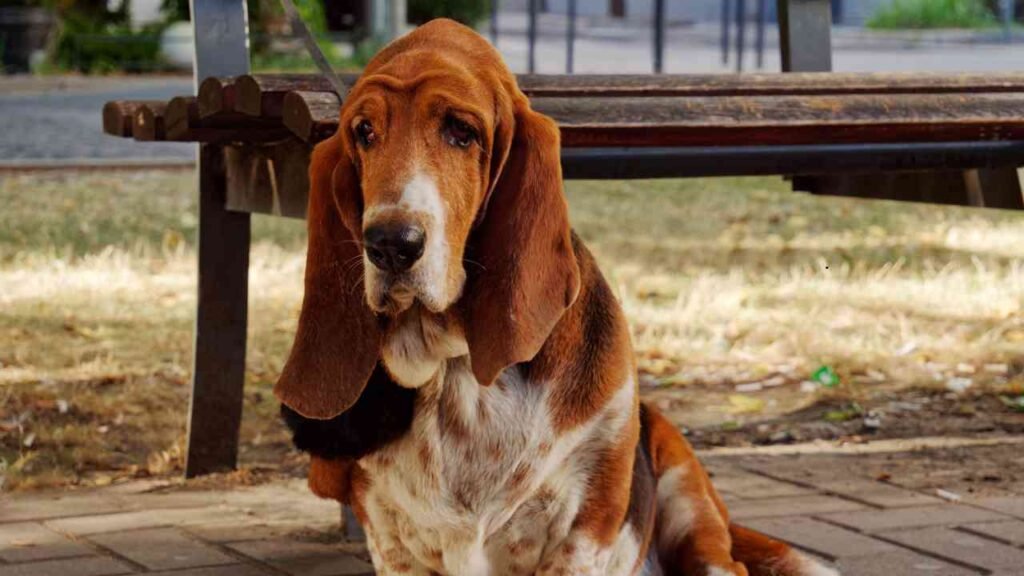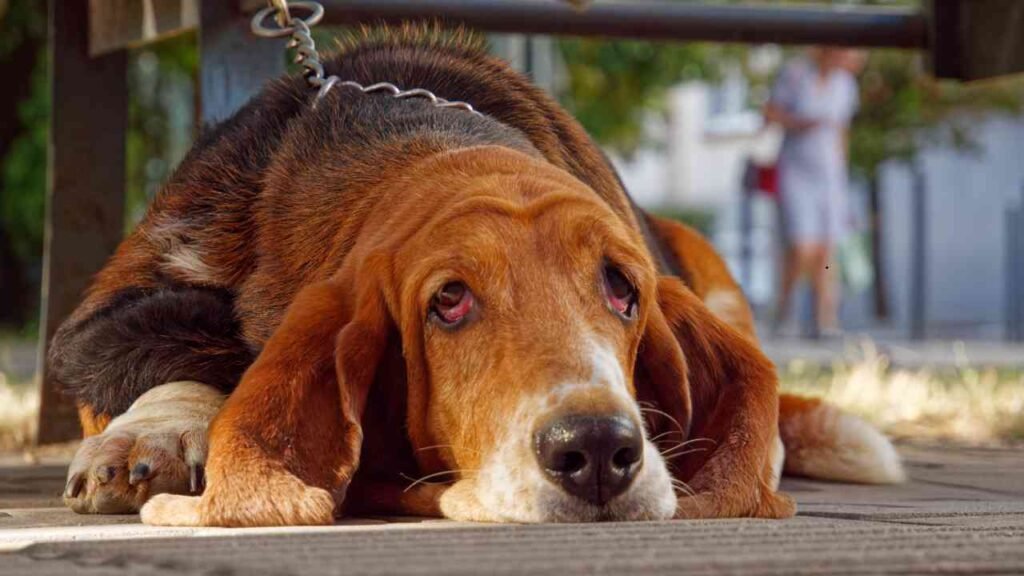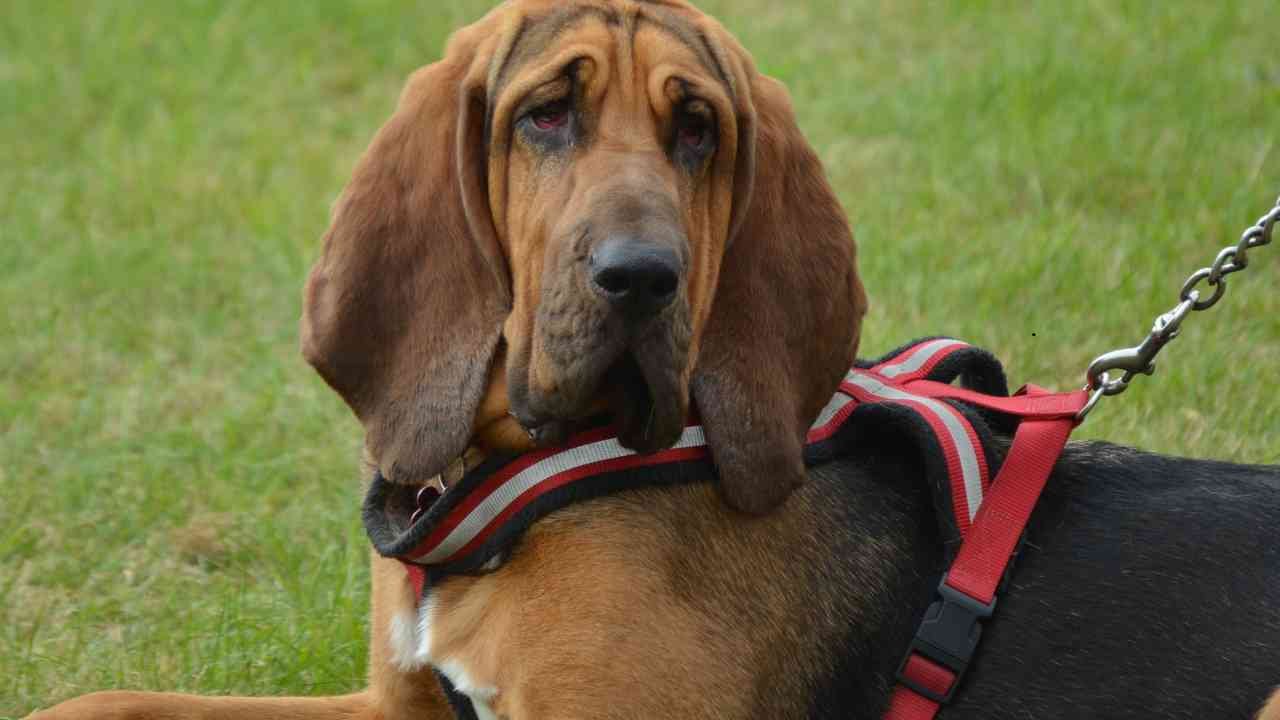Topics Covered in This Blog Post
- Introduction
- Breed Overview of Bloodhound
- History & Origin of Bloodhound
- Bloodhound Physical Appearance – Quick Overview
- Temperament & Behavior of Bloodhound
- Training Tips for Bloodhound
- Exercise Needs of Bloodhound
- Diet & Nutrition for Bloodhound
- Health & Lifespan of Bloodhound
- Is Bloodhound Right for You?
- FAQs about Bloodhound
Introduction
The Bloodhound is a large, noble-looking dog breed known for its unmatched tracking abilities and gentle nature. With its long, wrinkled face and droopy ears, the Bloodhound is instantly recognizable and admired for its calm demeanor and powerful nose. Originally bred for hunting and scent tracking, this breed is now appreciated both as a working dog and a devoted family companion.
Despite their serious look, Bloodhounds are affectionate and loyal, often forming strong bonds with their owners. They are excellent with children and generally get along well with other pets, making them a great choice for families who can meet their physical and mental needs.
Breed Overview of Bloodhound

The Bloodhound is a large, muscular scent hound that stands out for its tracking prowess. Males typically weigh between 90 to 110 pounds, while females weigh slightly less. Their strong build, deep chest, and long, loose skin help them in scent work, especially when working through dense forests or rough terrain.
Bloodhounds are calm, dignified, and persistent. They are not aggressive but are extremely focused when on a scent trail. This breed is ideal for owners who want a loyal, working-type dog with an even temperament and a strong instinct to explore.
History & Origin of Bloodhound

The Bloodhound has ancient roots, believed to have originated in medieval France and Belgium. The breed’s name comes from the term “blooded hound,” referring to its pure noble bloodlines. It was developed by monks, particularly in the Saint-Hubert Monastery, for the purpose of tracking game and lost people.
Bloodhounds were later refined in England, where their tracking skills were used by police and hunters alike. Today, they are still widely used in search and rescue operations due to their unmatched ability to follow scents over great distances — even days old.
Bloodhound Physical Appearance – Quick Overview
The Bloodhound has a distinct and powerful appearance that sets it apart from other breeds. It has a large, muscular frame with loose, wrinkled skin around the face and neck. One of its most recognizable features is its long, droopy ears and deeply sunken, expressive eyes that give it a thoughtful look.
This breed typically stands between 23 to 27 inches tall and weighs between 80 to 110 pounds. Its coat is short and dense, coming in colors like black and tan, liver and tan, or red. The long, strong tail often curves upward and is carried high when the dog is active or on a scent.
Temperament & Behavior of Bloodhound
Bloodhounds are known for their gentle, affectionate, and easygoing personality. Despite their serious expression, they are friendly dogs that enjoy human company and get along well with children and other animals. They are loyal and form strong bonds with their families, although they may be a bit reserved with strangers.
This breed is independent and determined, especially when following a scent. That focus can sometimes make them appear stubborn, but it’s simply their natural working instinct. Bloodhounds are also known for their deep, loud baying bark, which they use to alert their handlers when they’ve picked up a scent.
Training Tips for Bloodhound
Training a Bloodhound requires patience, consistency, and understanding of their unique temperament. They are intelligent and capable learners, but their independent nature and strong scent drive can make them easily distracted during training sessions.
- Use positive reinforcement like treats and praise to keep them motivated.
- Keep sessions short and engaging, as they may lose interest quickly if bored.
- Leash training is crucial, since Bloodhounds can suddenly follow a scent and ignore commands.
- Early socialization helps them adapt well to different people, pets, and environments.
With the right approach, a Bloodhound can become a well-behaved and loyal companion.
Exercise Needs of Bloodhound
Bloodhounds are active dogs with excellent stamina and require regular exercise to stay healthy and mentally balanced. Daily walks of at least 45 to 60 minutes are essential, along with opportunities to explore in safe, enclosed areas. Because of their strong tracking instinct, they love to follow scents, so scent games and trail walks are ideal.
Keep in mind that Bloodhounds can become bored if not mentally stimulated, which may lead to howling or destructive behavior. Off-leash time should always be in secure areas since they may ignore commands once they catch a scent.
Despite their energy outdoors, they are typically calm and relaxed indoors, making them well-suited to families with moderate activity levels who can commit to daily exercise.
Diet & Nutrition for Bloodhound
Feeding your Bloodhound a balanced and nutritious diet is key to maintaining their energy and overall health. Due to their large size, they require high-quality dog food that’s appropriate for large, active breeds. Choose formulas that include real meat, healthy fats, and essential vitamins and minerals.
Adult Bloodhounds typically do well with two measured meals per day to prevent overeating and reduce the risk of bloat — a serious condition in deep-chested breeds. Avoid vigorous activity immediately after meals.
Treats should be given in moderation, and fresh water should always be available. For specific nutritional needs, consult your vet, especially if your Bloodhound has sensitivities or health concerns.
Health & Lifespan of Bloodhound
Bloodhounds are generally healthy dogs but, like all breeds, they can be prone to specific health issues. With proper care, their average lifespan ranges between 10 to 12 years.
Common Health Concerns:
- Hip and elbow dysplasia: Common in large breeds, regular checkups and weight control help reduce risk.
- Ear infections: Their long ears can trap moisture, so regular ear cleaning is essential.
- Bloat (Gastric Torsion): A serious and sometimes fatal condition, it’s important to monitor their eating and activity habits.
- Skin infections and irritation: Their loose skin folds may need regular cleaning to avoid buildup of moisture and bacteria.
Routine veterinary visits, a healthy diet, and regular exercise can greatly increase their chances of a long, comfortable life.
Is Bloodhound Right for You?
The Bloodhound is a wonderful companion for the right owner, but it’s important to consider their unique needs and traits before making a decision. They are loyal, affectionate, and calm dogs, well-suited to families who can provide time, space, and patience.
You might enjoy owning a Bloodhound if:
- You have a spacious home or yard with secure fencing
- You enjoy outdoor activities like walking or hiking
- You’re patient and consistent with training
- You want a dog that is gentle with kids and other pets
- You appreciate a quiet, laid-back companion at home
A Bloodhound might not be right for you if:
- You can’t commit to daily exercise and mental stimulation
- You live in a small apartment without outdoor space
- You need a highly obedient dog (they can be independent)
- You are bothered by drool or shedding
- You can’t tolerate loud vocalizations — Bloodhounds are known for their deep baying
If you’re ready for a loyal, intelligent, and determined breed that’s also gentle and sweet, the Bloodhound may be your perfect match.
FAQs about Bloodhound
Q1: Are Bloodhounds good family dogs?
Yes, Bloodhounds are affectionate and gentle, making them excellent family pets, especially with children.
Q2: Do Bloodhounds get along with other pets?
They typically get along well with other dogs and household pets when properly socialized.
Q3: How much exercise does a Bloodhound need?
At least 45 to 60 minutes of daily exercise is recommended to keep them fit and mentally satisfied.
Q4: Are Bloodhounds hard to train?
They are intelligent but independent. Training requires patience, consistency, and positive reinforcement.
Q5: Do Bloodhounds drool a lot?
Yes, due to their loose skin and jowls, they tend to drool quite a bit, especially after eating or drinking.
Q6: Can Bloodhounds live in apartments?
They can adapt to apartment life if exercised daily, but a house with a yard is preferred due to their size and energy.
Q7: What health problems are common in Bloodhounds?
Common issues include hip dysplasia, ear infections, bloat, and skin fold infections.
Q8: How long do Bloodhounds live?
Bloodhounds typically live between 10 to 12 years with proper care.
Explore More Breeds and Conduct Further Research
